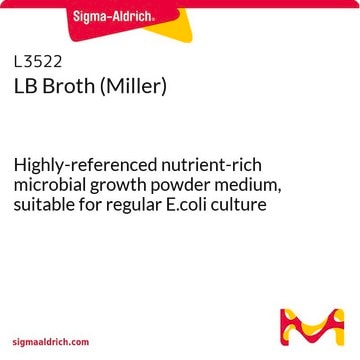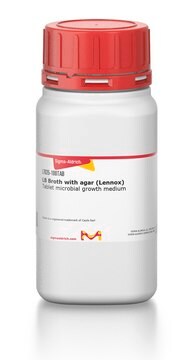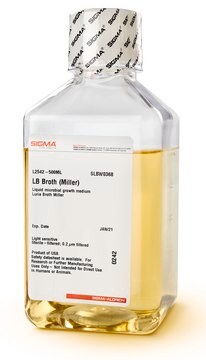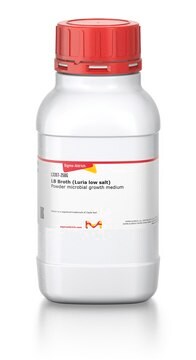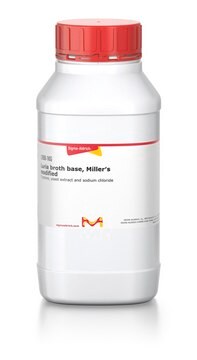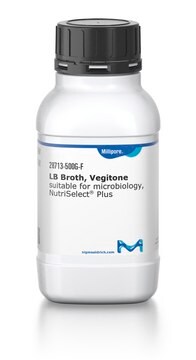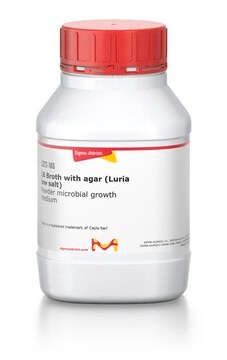L7275
LB Broth (Lennox)
Tablet microbial growth medium
Synonyme(s) :
Lennox broth , Luria Bertani Broth
Se connecterpour consulter vos tarifs contractuels et ceux de votre entreprise/organisme
About This Item
Code UNSPSC :
12352200
Nomenclature NACRES :
NA.85
Produits recommandés
Qualité
for molecular biology
Niveau de qualité
Stérilité
non-sterile
Forme
tablet
Technique(s)
microbiological culture: suitable
Application(s)
food and beverages
microbiology
Température de stockage
room temp
Adéquation
nonselective for Escherichia coli
nonselective for coliforms
Description générale
Dehydrated Luria-Bertani (LB) broth is called the Lennox LB, which has amino acids as carbon source.
Lennox LB is a highly-referenced microbial growth medium used for the cultivation of E. coli. This nutrient-rich microbial broth contains peptides, amino acids and carbohydrates in a low-salt formulation.
Application
LB Broth (Lennox) has been used for culturing Escherichia coli and bacterial artificial chromosomes (BACs).
Suitable for non-selective cultivation of E. coli strains for cloning, DNA plasmid production and production of recombinant proteins. Also suitable for selective cultivation when appropriate antibiotics are added, including those that require low-salt conditions, such as Zeocin®.
Caractéristiques et avantages
Lennox LB tablets provide:
- Convenient small package to eliminate weighing
- Fast preparation – no stirring required
Composants
10 g/L Tryptone
5 g/L Yeast Extract
5 g/L NaCl
2.2 g/L inert binding agents
5 g/L Yeast Extract
5 g/L NaCl
2.2 g/L inert binding agents
Reconstitution
Add each 1.1g tablet in 48.3mL water (no stirring required). Autoclave for 20 minutes at 121C to sterilize. Allow to cool before making additions, such as antibiotics (if desired).
Informations légales
Zeocin is a registered trademark of Cayla Sarl
Produit(s) apparenté(s)
Réf. du produit
Description
Tarif
Code de la classe de stockage
11 - Combustible Solids
Classe de danger pour l'eau (WGK)
WGK 3
Point d'éclair (°F)
Not applicable
Point d'éclair (°C)
Not applicable
Faites votre choix parmi les versions les plus récentes :
Déjà en possession de ce produit ?
Retrouvez la documentation relative aux produits que vous avez récemment achetés dans la Bibliothèque de documents.
Les clients ont également consulté
Escherichia coli Physiology in Luria-Bertani Broth
Sezonov G, et al.
Journal of Bacteriology, 189(23), 8746-8746 (2007)
Synthesis of antibacterial surfaces by plasma grafting of zinc oxide based nanocomposites onto polypropylene
De Rancourt Y, et al.
Journal of Colloid and Interface Science, 402, 320-326 (2013)
In Vitro packaging of λ dam vectors and their use in cloning DNA fragments.
Enquist, L. and Sternberg, N.
Methods in Enzymology, 68, 281-281 (1971)
Hybridization between Escherichia coli and Shigella.
Luria, S.E. and Burrous, J.W.
Journal of Bacteriology, 74, 281-281 (1957)
Fluorescence in situ hybridization of ductal lavage samples identifies malignant phenotypes from cytologically normal cells in women with breast cancer
Adduci KM, et al.
Cancer Cytopathology, 111(3), 185-191 (2007)
Notre équipe de scientifiques dispose d'une expérience dans tous les secteurs de la recherche, notamment en sciences de la vie, science des matériaux, synthèse chimique, chromatographie, analyse et dans de nombreux autres domaines..
Contacter notre Service technique

